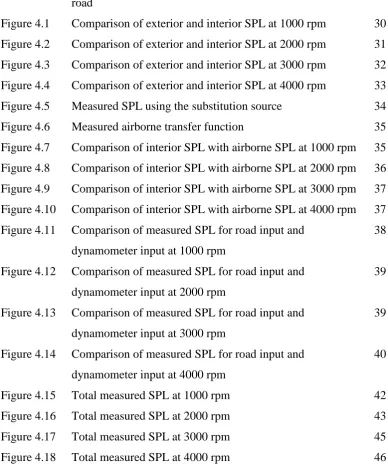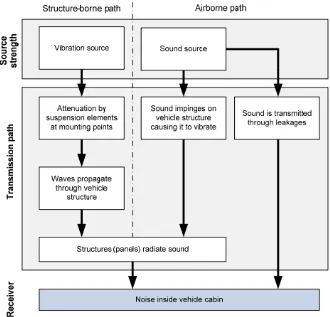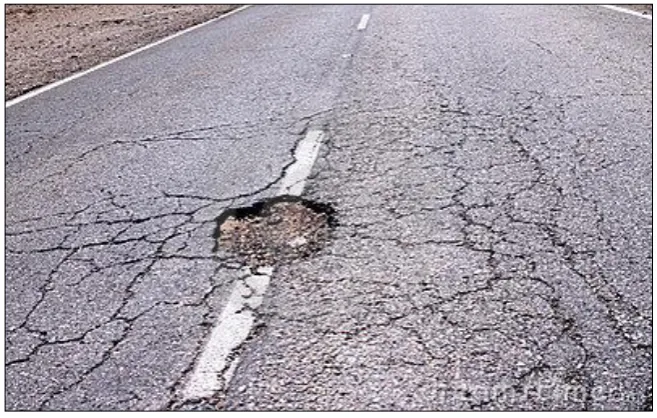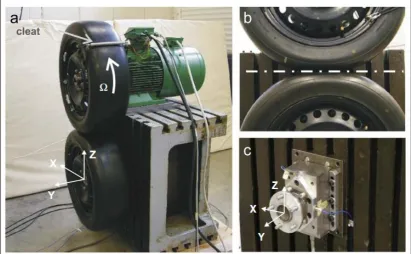MEASUREMENT OF STRUCTURE-BORNE NOISE FROM ROAD INPUT IN A MOTOR VEHICLE CABIN
WONG HEE KIONG
i
SUPERVISOR DECLARATION
―I hereby declare that I have read this thesis and in my opinion this report is sufficient in terms of scope and quality for the award of the degree of
Bachelor of Mechanical engineering (Thermal-Fluids)‖
Signature: ……….. Supervisor: Dr. Azma Putra
ii
MEASUREMENT OF STRUCTURE-BORNE NOISE FROM ROAD INPUT IN A MOTOR VEHICLE CABIN
WONG HEE KIONG
This report is submitted in fulfillment of the requirements for the award Bachelor of Mechanical Engineering (Thermal-Fluids)
Faculty of Mechanical Engineering Universiti Teknikal Malaysia Melaka
iii
DECLARATION
―I hereby declare that the work in this report is my own except for summaries quotations which have been duly acknowledged.‖
Signature: ……….. Author: Wong Hee Kiong
iv
ACKNOWLEDGEMENT
First and foremost, author would like to offer sincerest gratitude to Project Sarjana Muda (PSM) supervisor, Dr Azma Putra for his guidance, support and knowledge. Author also would like to express gratitude to entire PSM Organisation Faculty of Mechanical Engineering UTeM for their careful management for all the students.
v
ABSTRACT
vi
ABSTRAK
vii
TABLE OF CONTENTS
CHAPTER TITLE PAGES
SUPERVISOR DECLARATION i
DECLARATION iii
ACKNOWLEDGEMENT iv
ABSTRACT v
ABSTRAK vi
TABLE OF CONTENTS vii
LIST OF FIGURE ix
CHAPTER 1 INTRODUCTION 1
1.1 BACKGROUND 1
1.3 PROBLEM STATEMENT 3
1.4 OBJECTIVE 3
1.5 SCOPE 3
CHAPTER 2 LITERATURE REVIEW 4
2.1 VIBRATION 4
2.2 EVALUATION OF NOISE 5
2.3 EVALUATION OF VIBRATION 6
2.3.1 Vibration Due to Tire-Road Interaction 7 2.3.2 Vibration Due to Road Discontinuities 10 2.3.3 Vibration Due to Excitation of Suspension
System and Engine Transmission 11 2.4 ESTABLISHED MEASUREMENT TECHNIQUES 12
2.4.1 Experimental Analysis of the Structure-borne Tire-road Noise Due to Road Discontinuities 13 2.4.2 Experimental Study of Structure-borne Noise
viii
CHAPTER 3 METHODOLOGY 16
3.1 OVERVIEW 16
3.2 FLOW CHART 17
3.3 DIRECT MEASUREMENT 17
3.3.1 Interior Airborne Noise Measurement Using
Substitution Method 19
3.3.1.1Data Processing 23
3.3.2 Interior Noise Measurement from Dynamometer 24 3.3.3 Interior Noise Measurement from Road Input 27
CHAPTER 4 RESULTS AND DISCUSSION 29
4.1 INTERIOR AIRBORNE NOISE MEASUREMENT BY USING SUBSTITUTION METHOD 29 4.1 COMPARISON BETWEEN MEASURED SPL
FOR ROAD AND DYNAMOMETER INPUT 38
4.3 TOTAL MEASURED SPL 40
CHAPTER 5 CONCLUSION AND RECOMMENDATION 47
5.1 CONCLUSION 47
5.2 RECOMMENDATION 48
REFERENCES 49
ix
LIST OF FIGURE
[image:10.595.116.507.242.752.2]NO TITLE PAGES
Figure 2.1 Diagram of noise transmission path (Putra et al., 2012) 6 Figure 2.2 Car vibration and noise (Graf et al., 2002) 7 Figure 2.3 Vibration in tire (Kim et al., 2007) 8
Figure 2.4 Road cracks 11
Figure 2.5 Pothole 11
Figure 2.6 a) Test setup with two tires mounted. b) Static tire deformation due to preload. c) Multiaxial wheel hub dynamometer (Kindt et al., 2009)
13
Figure 2.7 a) Emulated powertrain. b) Structure-borne transmission paths of the experimental system (Kim et al., 2005)
15
Figure 3.1 Flow chart for PSM 1 and PSM 2 17 Figure 3.2 Figure 3.2: Calibration of sound level meter 19 Figure 3.3 Methodology for airborne noise measurement using
substitution method
20
Figure 3.4 Exterior noise measurement 20 Figure 3.5 Exterior noise measurement by using substitution method 21 Figure 3.6 Interior noise measurement 21 Figure 3.7 Interior noise measurement by using substitution method 22 Figure 3.9 22Position of the loudspeaker 22 Figure 3.10 Noise measurement procedures on dynamometer 25 Figure 3.11 Measurement setup for dynamometer input 25 Figure 3.12 Test vehicle running on dynamometer 26 Figure 3.13 Attached sound level meters 26
x
Figure 3.14 Noise measurement procedures for vehicle running on the road
[image:11.595.118.507.96.573.2]28
Figure 4.1 Comparison of exterior and interior SPL at 1000 rpm 30 Figure 4.2 Comparison of exterior and interior SPL at 2000 rpm 31 Figure 4.3 Comparison of exterior and interior SPL at 3000 rpm 32 Figure 4.4 Comparison of exterior and interior SPL at 4000 rpm 33 Figure 4.5 Measured SPL using the substitution source 34 Figure 4.6 Measured airborne transfer function 35 Figure 4.7 Comparison of interior SPL with airborne SPL at 1000 rpm 35 Figure 4.8 Comparison of interior SPL with airborne SPL at 2000 rpm 36 Figure 4.9 Comparison of interior SPL with airborne SPL at 3000 rpm 37 Figure 4.10 Comparison of interior SPL with airborne SPL at 4000 rpm 37 Figure 4.11 Comparison of measured SPL for road input and
dynamometer input at 1000 rpm
38
Figure 4.12 Comparison of measured SPL for road input and dynamometer input at 2000 rpm
39
Figure 4.13 Comparison of measured SPL for road input and dynamometer input at 3000 rpm
39
Figure 4.14 Comparison of measured SPL for road input and dynamometer input at 4000 rpm
40
1
CHAPTER 1
INTRODUCTION
1.1 BACKGROUND
Vehicle interior noise increasing attracts attention from researchers and manufacturers since the past decades as it crucially affects the level of acoustic comfort of the passengers, especially for (luxury) sedans with pleasant low-noise engine sounds. Vibration caused by tires due to forces radiated by the road-tire interaction during rolling over a rough road surface is an important noise contribution in the vehicle cabin over a wide frequency range. This noise contribution to interior noise depends on the source levels and the reduction of noise from the exterior to the interior. The amount of acoustic discomfort in the passenger compartment generated by vibration is depends on the magnitude, frequency, direction and the duration of exposed vibration in the cabin (Junoh et al.).
2
Due to advancement in today‘s telecommunication in which most of (luxury) vehicles are equipped with interactive voice control, information and multimedia systems, and increased use of mobile phones, interior acoustic comfort is one of the main factors which attract the buyers in this extremely competitive automobile market of future design and sales (Douville et al., 2006).
3
1.3 PROBLEM STATEMENT
Vehicle interior noise crucially affects the level of acoustic comfort of passengers. At lower frequencies, the interior noise from road input is predominantly transmitted through structure-born route. A simple measurement method is therefore required to be proposed to measure structure-borne noise from road input in vehicle cabin, thus enable car manufacturers to determine the source of noise.
.
1.4 OBJECTIVE
The main objective of this research is to measure the structure-borne noise in a motor vehicle cabin from tires-road interaction and to propose a simple technique to measure the noise in the vehicle cabin.
1.5 SCOPE
4
CHAPTER 2
LITERATURE REVIEW
2.1 VIBRATION
According to Hassan (2009), vibration is defined as motion or oscillations of particles or a body or a system which can be defined by displacement, velocity or acceleration of the particles from a position of an equilibrium point. Vibration occurs when a system is displaced from a position of stable equilibrium and when this happened; restoring forces such as elastic forces or gravitational forces tends to act on the system to return the displaced system back to the equilibrium or initial position. The system keeps moving forth and back across its position of equilibrium thus creating a periodic motion and can be deterministic or random in nature. Vibration is generally expressed in terms of frequency such as cycles per second or commonly known as Hertz (Hz), revolutions per minutes (rpm) and strokes per minute (spm).
5
constant source of power associated with the system which, owing to some mechanism inherent in the system that gives rises to oscillating forces (Ehrich, 2009). Most vibrations are undesirable be it in machines, structures, vehicle and etc. as they produce energy losses, induce fatigue, increase stresses and create passenger discomfort in vehicles.
2.2 EVALUATION OF NOISE
Generally, transmission paths of noise from road input are vital in the study of vehicle interior noise. Sound transmission into vehicle cabin is classified into two categories namely airborne noise or structure borne noise. Airborne noise is the noise that radiated directly from a vibrating structure due to impinging sound pressure into the surrounding air. In a vehicle, noise is transmitted into the cabin through leakages due to failure of sealing, for instance, around the door and window seals or grommets in the bulkhead (Harrison, 2004).
On the other hand, a structure borne noise is resulted from vibration of car structure which generates sound energy into the cabin when the tires travel on a non-uniform road surface. The noise is typically generated by the suspension mounting points, car engine, exhaust and other parts of a vehicle. Figure 2.1 shows the diagram of noise transmission path into the vehicle cabin.
6
[image:17.595.155.485.120.437.2]and at the same time to decrease the noise in vehicle cabin to enhance acoustic comfort.
Figure 2.1: Diagram of noise transmission path (Putra et al., 2012)
2.3 EVALUATION OF VIBRATION
7
Figure 2.2: Car vibration and noise (Graf et al., 2002)
The total amount of vibration received by human over a period of time can be assessed by using vibration dose value (VDV) formula. Basically, VDV (ms-1.75) is the measure of total exposure to vibration which magnitude, vibration exposure duration and frequency are taking into account. VDV can be defined as below:
(∫ ( ) ) ⁄
Where VDV: Vibration dose value (ms-1.75) a (t): Frequency-weighted acceleration
T: Total period in seconds that the vibration occurred
2.3.1 Vibration Due to Tire-Road Interaction
8
[image:19.595.145.493.133.356.2]for different frequency and speed ranges or for different road and tire conditions (Kim et al., 2007).
Figure 2.3: Vibration in tire (Kim et al., 2007)
According to Kim et al. (2007), the dominant noise generation mechanism for tire noise below 1 kHz is the tire wall vibration caused by collisions between the tread blocks and the road. At frequency above 1 kHz, all of these noise generation mechanisms have been considered as important contribution to the noise generation.
Tire wall vibration is the major source of tire noise at frequency below 1 kHz and this is due to several mechanisms as follow:
Tire vibration is caused by the tire tread pattern which produces load modulation. According to Kim et al. (1997), the excitation force of tire vibration is solely due to the tire tread pattern only when the road surface is smooth that its wavelengths are less than those of tire pattern element (pitch length).
9
component at the leading edge and the increase of velocity component at the training edge resulted in a huge deceleration and acceleration which become the source of tire vibration (Kim et al., 1997).
Tire vibration is also due to the tire non-uniformity which excites carcass and tread vibration.
Roughness of the road generates tire vibration in form of analogous to the vibrations produced by the tread pattern.
Generally, air pumping mechanism occurs when tire tread is compressed in radial, lateral and longitudinal directions due to the collisions of road surface with a portion of tire tread. These tread compressions at the leading edge forces and squeeze air out of the groove of the tire when the volume of the groove is reduced. Air pumping is a result of pumping, forcing and squeezing the air out of the tire groove (Hayden, 1971).
Furthermore, air resonant radiation occurs when a tread block at the trailing edge leaves the contact road surface, a Helmholtz resonator is formed due to the groove volume and groove opening (Nilsson, 1979). Helmholtz resonator can be described as the groove volume behaves like a spring and the air flow in the groove opening acts like a mass. There is an expansion of the groove volume and a fast inflow of air result when the groove opened at the trailing edge. According to Nilsson (1979), a high frequency at about 1000-2000 Hz tone bust is generated as the groove releases from the road contact.
10
Nonetheless, research done by Saemann et al. showed that the radiated noise in the frequency range up to 500 Hz is independent of the tire tread pattern. They presented that the main noise contribution in the passenger compartment is due to the tire construction.
2.3.2 Vibration Due to Road Discontinuities
Vibration is highly dependent on the roughness of the road surface where the tires are rolling on, with the rougher the surface of the road generating more vibration. The term road discontinuities refers to the road pavement defects such as road cracking, potholes, rutting, sewer manholes and junctions between concrete road surface plates. Driving across these road discontinuities causes vibrational and acoustical discomfort to the passengers inside the vehicle. This interior noise can reach significant peak levels as a result of crossing such road discontinuity (Kindt et al., 2009).
11
Figure 2.4: Road cracks
Figure 2.5: Pothole
2.3.3 Vibration Due to Excitation of Suspension System and Engine Transmission
[image:22.595.155.484.324.533.2]12
since it arises from the excitation of the tire rolling or contact on a random road profile. This generated broadband vibrations by the road irregularities are transmitted thru suspension, car structural and other solid parts up to the vehicle cabin (Park et al., 2001).
From the research conducted by Douville et. al. (2006), the most significant resonance of a typical suspension that can be observed on all frequency response function (FRF) is the natural frequency of the entire suspension at 24.4 Hz. They concluded that at this frequency, the entire suspension exhibit ―wheel-hop resonance‖ in which it moves with a large-amplitude vertical displacement (z-direction) when encountered road irregularities. This dynamic characteristic of suspension is responsible for the road induced structure borne vibration and noise at lower frequency of 600 Hz and below.
2.4 ESTABLISHED MEASUREMENT TECHNIQUES
13
2.4.1 Experimental Analysis of the Structure-borne Tire-road Noise Due to Road Discontinuities
An experimental analysis of road discontinuities induced structure-borne tire-noise interaction tire-noise had been conducted by Kindt et al. (2009) to analyse the peak noise levels as a result of driving across road discontinuities. These road discontinuities are the deformations of road which are potholes, road cracks and etc. as well as the purposely man-made road irregularity for other purposes such as expansion joints, railway crossings, sewage holes and so on.
[image:24.595.114.526.406.660.2]In this research, they designed and created a novel test setup at the K.U Leuven Noise and Vibration Engineering Laboratory in order to measure the structural and acoustic response of a tire rolling over a cleat. The cleat is used in this experiment to serve the purpose as the road discontinuities. This test setup is shown in the figures below.
Figure 2.6: a) Test setup with two tires mounted. b) Static tire deformation due to preload. c) Multiaxial wheel hub dynamometer (Kindt et al., 2009)






